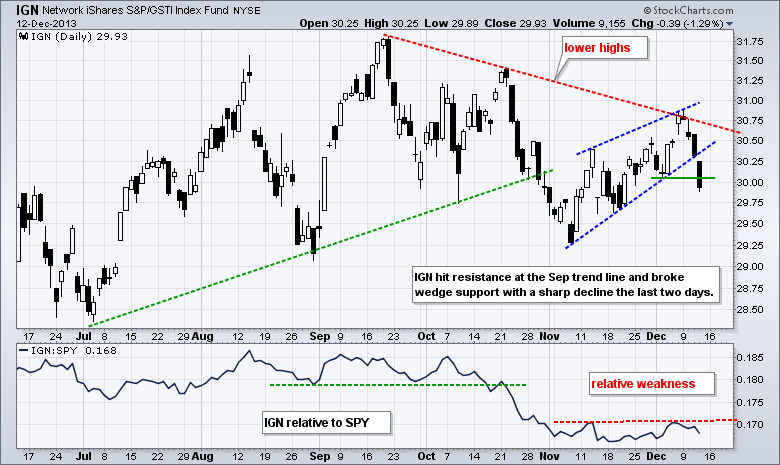Stocks put in a mixed performance on Thursday as the Russell 2000 ETF (IWM) edged higher and the Nasdaq 100 ETF (QQQ) edged lower. The sectors were also mixed with the Consumer Staples SPDR (XLP) taking the biggest hit (-1.38%). Techs were under pressure from the Networking iShares (IGN) and the MarketVectors Semiconductor ETF (SMH), both of which fell over 1%. It appears that taper talk is still taking its toll because the Gold SPDR (GLD) and the Silver Trust (SLV) fell sharply. Tapering got yet another positive vote as Retail Sales grew .7% in November. Again, the market appears to be on edge because the prospects of tapering are increasing and the Fed has a meeting next week. While I am not sure that the Fed will clear the air on tapering next week, the market could indeed breathe a sign of relief once this meeting passes. In fact, the end of the Fed meeting could signal the start of the Santa Claus rally.
**This chart analysis is for educational purposes only, and should not
be construed as a recommendation to buy, sell or sell-short said securities**



**************************************************************

**************************************************************

**************************************************************

**************************************************************

***************************************************************
Key Reports and Events (all times Eastern):
Fri - Dec 13 - 08:30 - Producer Price Index (PPI)
Charts of Interest: Tuesday and Thursday
This commentary and charts-of-interest are designed to stimulate thinking. This analysis is not a recommendation to buy, sell, hold or sell short any security (stock ETF or otherwise). We all need to think for ourselves when it comes to trading our own accounts. First, it is the only way to really learn. Second, we are the only ones responsible for our decisions. Think of these charts as food for further analysis. Before making a trade, it is important to have a plan. Plan the trade and trade the plan. Among other things, this includes setting a trigger level, a target area and a stop-loss level. It is also important to plan for three possible price movements: advance, decline or sideways. Have a plan for all three scenarios BEFORE making the trade. Consider possible holding times. And finally, look at overall market conditions and sector/industry performance.

